Both the .22-250 Rem and the .243 Win are widely used in small to medium-game hunting across the world.
With a really competitive score, both of those rounds have a slight edge over the other.
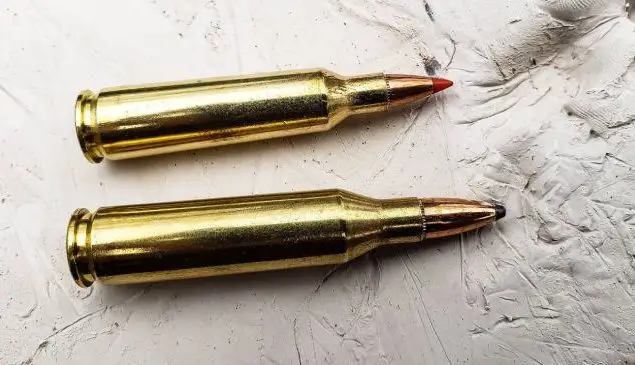
The .22-250 Rem rounds are known as “The Varmint hunting rounds,” whereas the .243 Win rounds are widely popular as the “whitetail round.”
The .22-250 rounds are lighter and faster. The .243 Win rounds combat the odds with higher muzzle energy and versatility.
But which one would win a head-to-head “22-250 vs 243” comparison? Let’s find out!
Let’s meet the .22-250
These cartridges have many names. Some of the most famous names of the compact .22-250 cartridges include .22 Varminter and .22-250 Remington.
.22-250s are high-velocity, short-action rifle cartridges that are widely used to hunt small game animals like varmints and coyotes.
Known for the hydrostatic shock induced at the target, the .22-250 also has enough power to hunt deer. Due to a lower recoil count, they are a popular choice among female hunters.
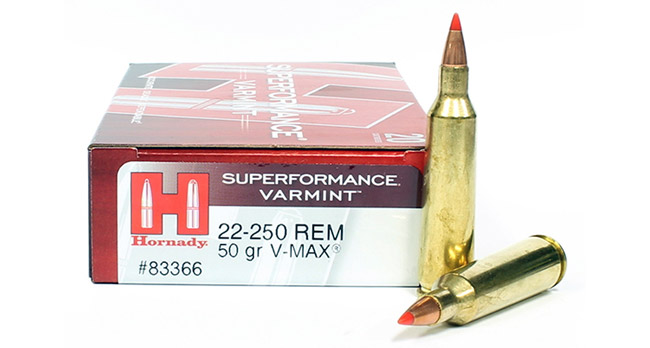
The .22-250 rounds entered the market in 1965.
These fast and powerful cartridges were used by the British Special Air Service and the Australian Special Air Service Regiment in the 1980s.
A little about the .243
Also known as the Whitetail round/the .243 Winchester, these rounds took whitetail hunting by storm after their introduction in 1955.
They are still popular for hunting small-medium games, from varmints all the way up to blacktail deer, pronghorns, and mule deer.
With a high velocity and a low amount of recoil, the .243 Winchester also features exceptional accuracy within 300 yards.
They are the first choice of many target shooters and metallic silhouette shooters across the globe.
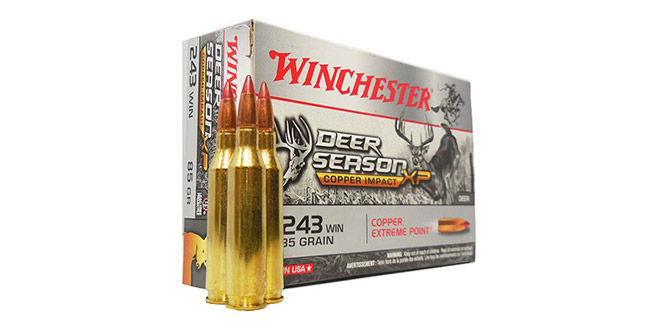
Despite being fast, accurate, and powerful, the mild but wild .243 Winchester rounds have never been used in the military.
.22-250 vs .243: What’s The Difference
1. Dimensions
.22-250
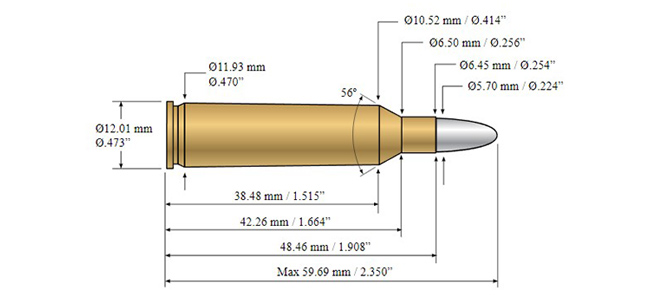
Let’s start the comparison with the 22-250 vs 243 bullet size, and cartridge dimension.
The .22-250 Rem cartridges are a bit smaller in every dimension, providing better speed and control over the trajectory.
That’s why they’re an excellent choice to use in bolt-action rifles.
However, the shorter dimensions also feature less firepower, resulting in comparatively lower muzzle energy.
The dynamic .22-250 was designed to minimize pelt damage. Here’s where the .22-250 takes the lead because today’s challenger (.243 Win) isn’t very fur-friendly.
.243
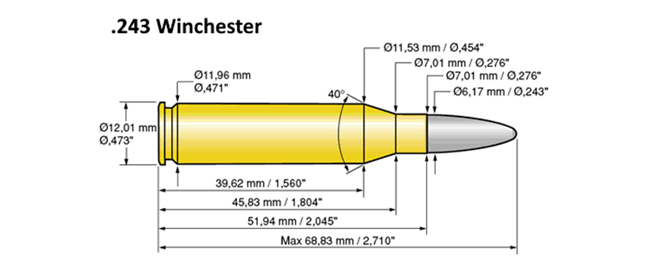
With larger dimensions, the mighty .243 Win rounds feature more energy that can be used to take down small to medium games effectively.
These powerful rounds can reach up to 2,900 fps with a 1,950 ft-lb energy, which is perfect for deer hunting.
This brought worldwide fame and made the rounds known as the “Whitetail Rounds.”
These cartridges are also decent at long-range shooting or target practice.
Feature .22-250 Rem .243 Win Parent casing .250-3000 Savage .308 Win Base diameter 0.47” 0.471” Bullet diameter 0..224” 0..243” Neck diameter 0.245” 0.276” Case length 1.912” 2.045” Overall length 2.24” 2.7098” Case capacity 44.6 gr H2O 53-54.8 gr Max pressure (SAAMI) 53,000 psi 60,000 psi
2. Trajectory
.22-250
The .22-250 rounds are famous for their speed, and the less time the bullet is in the air, the less gravity will have time to pull it downward.
As a result, At close range, the trajectory of .22-250 Rem cartridges is seemingly flat.
However, that isn’t enough to take down the mighty .243 Win rounds.
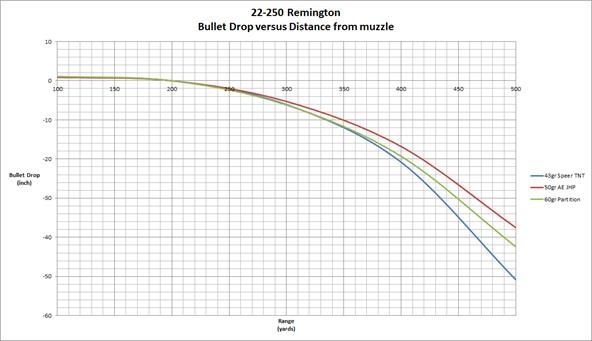
.243
The .243 Win is a perfect combination of power and speed.
The seemingly flat trajectory allows the .243 rounds to go on par with 300 Win Mag and 6.5 Creedmoor rounds, which are globally known to have flat trajectories within close ranges.
The additional firepower driving the .243 Win rounds provides a slightly better trajectory in close ranges.
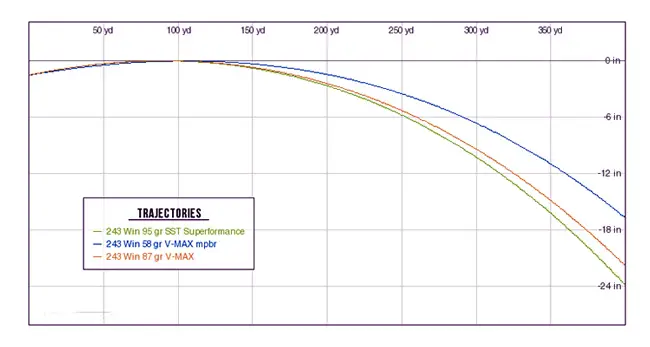
3. Recoil
.22-250
Everybody has their own tolerance for recoil. The .22-250, being the lighter of the two, provides significantly lower recoil energy on your shoulder.
With the .22-250 Rem cartridges, you’ll feel only a slight tap of about 6.7 ft-lbs on your shoulder.
That’s why these rounds are popular among people who don’t like to handle heavier recoil energy.
.243
With the .243 Win bullets, you’ll feel a bit of a rigid slap on the shoulder instead of a subtle tap.
These rounds generate around 11.25 ft-lbs of energy. Even though they are known as “shoulder-friendly,” on today’s 243 vs 22-250 trial, it weighs the rounds down a bit.
For those interested in the .243 but distressed with the recoil count, you can use a recoil pad to soften the blow even more.
Calibar Velocity (fps) Energy (ft-lb) .22-250 Rem 3790 1620 .243 Win 3180 1950
4. Accuracy
.22-250
Most people will hardly notice the difference between the .22-250 and the .243 in terms of accuracy.
Even if the accuracy greatly varies depending on the shooter, both these powerful cartridges will provide exceptional accuracy, mainly due to their flatter trajectory.
Both these cartridges are known to provide superb accuracy at close range.
However, the amount of recoil will also influence the accuracy of the .243 more than the .22-250, giving the .22-250 Rem rounds a slight edge over the competition.
.243
Both our contestants today are capable enough to obtain sub-MOA accuracy.
However, even if the recoil is minute, it will affect your accuracy; especially in longer ranges. With more firepower comes more recoil and that is what keeps the mighty .243 rounds in shadow today
5. Availability
.22-250
The .22-250 has been around for over half a century. As a result, it has become one of the main features of almost every major ammo manufacturer (like Barnes, Winchester, Federal, Fiocchi, and Hornady).
However, the rounds are not cheap.
Each round can cost from $1.50 (Practice ammo) to $2.50 (Dedicated hunting rounds).
As for the rifles, every major firearm manufacturer also has at least one bolt-action rifle that can chamber the versatile .22-250 rounds.
.243
The .243 Win can go on par with the .22-250 Rem in terms of price range and availability.
Just like the .22-250, almost all major firearm manufacturers have a bolt action or lever action that can shoot .243 rounds.
You can also find a wide variety to try out when it comes to reloading your cartridges by hand.
However, with a slightly more comprehensive selection of bullets and loads to choose from, the .22-250 is at a slight advantage.
6. Sectional density
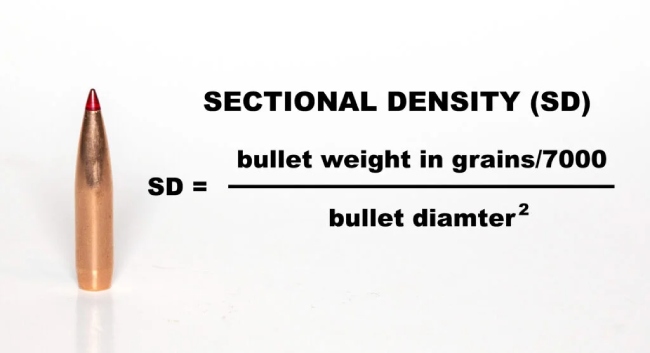
.22-250
It is the measurement of how well a bullet can penetrate a target. The higher the SD count, the deeper the bullet will go. This is especially important for long-range shooting.
As a varmint hunting round, we aren’t looking for a higher SD count as that can damage the pelt beyond help.
The .22-250 takes the lead in varmint hunting with an SD count of 0.171 (60 gr Nosler Ballistic Tip).
.243
The .243 Win rounds are popular in deer hunting and, as a result, have a slightly higher SD count than .22-250 rounds.
These rounds have both lighter varmint loads (55-70 gr) and heavier deer hunting loads (80-100) that produce an SD count of 0.14 and 0.24, respectively.
Even if the .22-250 has a slight edge over the SD count, the variety to choose from in a deer hunting load or a varmint load puts the .243 Win rounds back on the track.
7. Ballistic coefficient
.22-250
In short, the Ballistic coefficient (BC) indicates how well a bullet can resist wind drift and air resistance.
The higher the BC count, the better the bullet will perform in the air. The average BC count of the .22-250 Rem rounds is around 0.323.
.243
The .243 Win round, with a slightly higher BC count (0.34), takes the cake here.
What it means is that the additional firepower used in the .243 rounds (53-54.8 gr) provides a slightly better air resistance.
This makes the .243 cartridges exceptionally good for hunting whitetail deer.
8. Use
.22-250
The .22-250 rounds are so prevalent in varmint hunting that the whole caliber has become synonymous with the word “varmint hunting.”
After being widely adopted in 1963, these rounds have been used in hunting prairie dogs, coyotes, feral pigs, and groundhogs across the globe.
The .22-250 was designed for hunting varmints over a long distance, and after half a century, the .22-250 has become a benchmark to compare and measure all other 55 gr varmint ammo.
.243
The .243 Win cartridges secure the crown here with a wide range of weights (55-100 gr) that can be used in varmint hunting and deer hunting alike.
For varmints and other small games, a lighter bullet (55 gr) will make sure that the pelt isn’t damaged excessively.
For medium-sized games like deer, you’ll need a heavier bullet to penetrate through the hides and bones.
A 100 gr .243 Win bullet will carry around 1,000 ft-lbs of energy up to 250-300 yards, which is ideal for taking a deer down humanely.
.243 vs .22-250 Cartridge: Who’s the winner?
So, who’s the winner of the .22-250 vs .243 debate?
The answer to this question will always depend on what you are trying to shoot and from how far.
For those who are primarily looking for varmint hunting, you can pick either one.
Both the .22-250 Rem and the .243 Win do great at close ranges. They will take the varmint down without causing severe damage to the pelt.
The two rounds are so similar in this aspect that most shooters will hardly notice any difference between .22-250 and .243.

Harvesting trophies from long-range, however, is a different story.
Here, .243 Win cartridges are a clear choice. That way, you can hunt your trophy down with enough firepower for a humane kill.
FAQs
1. Is a .22-250 Big Enough For Deer?
Ans: Yes. .22-250s are powerful enough to take down whitetails without any issues. However, choosing the right bullet and proper shot placement is crucial for a humane kill.
2. Is .243 Too Big For Coyotes?
Ans: Not really. Though the .243 Win rounds are usually a bit heavier and more powerful than the .22-250 Rem rounds, the .243 Win also features lighter bullets (55 gr) which will work just fine for coyotes.
3. What’s The Effective Range of a .22-250 Bullet?
Ans: Around 250 yards. After that, the bullet stops being competitive and after 350 yards, the bullet becomes unable to hold itself while passing through the wind. The highest distance the .22-250 can travel is around 400-500 yards.
4. How Far Will a .243 Shoot Effectively?
Ans: Around 300-400 yards. If all the other conditions are just right, a 100 gr .243 Win bullet will carry around 1000 ft-lb of energy even after crossing 400 yards.








